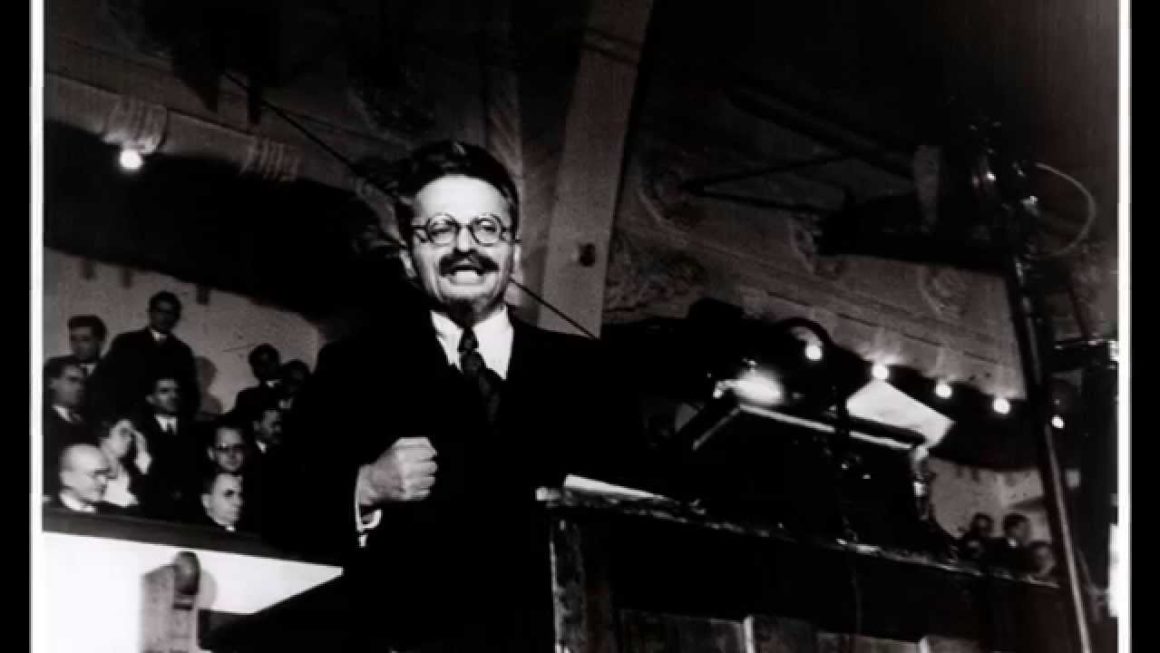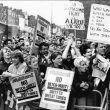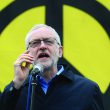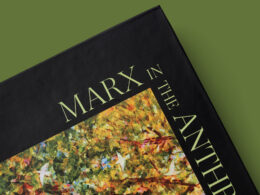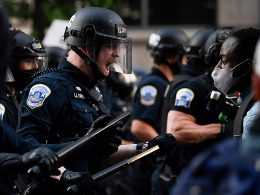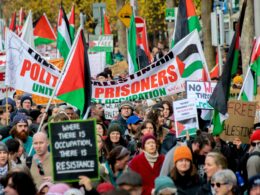Trotsky was one of the 20th century’s key figures: co-leader of the Russian revolution and tireless fighter against Stalin’s counter-revolution. Assassinated in 1940, he defended the ideas of democratic socialism to the end – against both capitalist exploitation and Stalinist dictatorship. The timely republication of an important biography is a chance for a new generation to discover what Trotsky stood for. And, Peter Taaffe writes, of his vital relevance today.
The Life and Death of Leon Trotsky
Natalia Sedova and Victor Serge
Published by Haymarket Books, 2016, £12.99
Trotsky is back in the news, partly because Tom Watson, deputy leader of the Labour Party, attacked the ‘Trotskyists’, specifically the Socialist Party (formerly Militant), with allegations about our role in supporting Jeremy Corbyn. In truth, the political influence of Trotsky never went away. The Socialist Party, through its consistent work in the trade unions, the workers’ movement and among the youth and working class generally, used his methods to maintain and build a significant presence in Britain and elsewhere in what was a difficult period for the labour movement.
Now, the fundamentally changed economic and social situation – an intractable and enduring economic crisis of capitalism and right-wing social democracy typified by discredited Blairism – has meant that workers and youth are searching for a fighting alternative. So when the ideological bedfellows of Blairism – like Watson – attack Trotsky it naturally kindles an interest in precisely what he stood for. And the republication of The Life and Death of Leon Trotsky is an excellent introduction to one of the greatest leaders of the Russian and world working class.
My Life, Trotsky’s autobiography written in exile in Turkey, is the definitive account of his life and work up to 1930, when it was published. The Life and Death of Leon Trotsky, published for the first time in decades, was the product of a joint enterprise between Natalia Sedova, Russian revolutionary and Trotsky’s widow, and Victor Serge, revolutionary and writer. It is complementary overall to My Life. This is despite some deficiencies, particularly in the criticisms by Serge of Trotsky and of the Bolshevik political method at the end of the book, which are published here for the first time.
Trotsky’s character and the massive contribution he made in two revolutions – in 1905 (the ‘dress rehearsal’ for 1917) and in the monumentally successful 1917 October revolution itself – are clearly brought out. No less important – in fact Trotsky’s greatest contribution – was his subsequent analysis of the increasingly bureaucratic degeneration of the revolution through Stalinism. Hounded by Stalin’s murder gangs and allegedly ‘politically isolated’, Trotsky’s matchless analysis has stood the test of time. Without his theoretical clarity, subsequent generations would have been able to grasp perhaps only with difficulty and delay the complex and contradictory phenomenon of Stalinism.
Trotsky’s relevance today
However, we are not dealing here merely with historical experiences, long forgotten and with no relevance to the modern labour movement. Firstly, in Britain, the issue of Trotsky and ‘Trotskyism’, and the role of the Socialist Party through our critical support for Jeremy Corbyn in the Labour leadership election, have forced their way into the bourgeois media and thereby into the popular consciousness of the labour movement. Secondly, the 100th anniversary of the Russian revolution falls next year. It is likely that the ideas and methods of Trotsky, alongside those of Lenin, will occupy centre stage. Inevitably, they will be distorted by bourgeois historians, academics, journalists, etc.
The Life and Death of Leon Trotsky, in part at least, can serve as a preparatory antidote to the inevitable poison which the mere mention of Trotsky’s name tends to generate in bourgeois circles and their ideological hangers on. There is, unfortunately, an increasingly similar reaction today from the leaders of Momentum, originally set up to support Jeremy Corbyn in his leadership campaign but increasingly resorting to bureaucratic attempts to suppress and shout down alternative viewpoints, particularly of Socialist Party supporters. If, on the coat-tails of Jeremy Corbyn’s campaign, they become a majority within the Labour Party and capture its machine, how long will it be before they replace the right wing’s Compliance Unit – described by John McDonnell as carrying out a purge – with their own version?
This book shows the futility of such methods. If Stalin, with the resources of a mighty state, could murder Trotsky and wipe out a whole generation of revolutionaries but not defeat his ideas, what chance is there for petty-bourgeois bureaucratic methods to triumph in this period, when workers and young people have a thirst for discussion and debate?
The book covers the decisive periods of Trotsky’s political life: the time up to the revolution, the events of the revolution itself, and the conquest of power. Dust is being thrown into the eyes of the new generation in particular over the Russian revolution and its place in history. We are bound to be treated to accounts of the ‘bloodthirsty character’ of both the Bolsheviks and the revolution. Natalia Sedova and Victor Serge answered many of these expected charges in advance. Trotsky also anticipated this in My Life, when commenting on the first world war: “Had the lies of war been explosives there would have been enough to blow up the entire planet”.
The same applies to the class war. On one occasion Trotsky urged Lenin to write down, to put on record, certain decisions “lest future historians misrepresent them”. Lenin replied: “They will never stop lying, whatever we do”. Yet truth will out despite the monstrous lying machines of capitalism and, in the past, Stalinism. The new generation of workers and youth have increasingly turned to Trotsky’s works which, if they were gathered together, would take up more than 50 volumes. This is necessary in order to understand the nature of capitalism and to forge the political weapons to effect socialist change.
Leadership and democracy
The honesty and modesty of Lenin and Trotsky before history is recognised again and again in this book. One incident illustrates the method of Lenin in relation to his own role. He had sent notes to the Bolshevik Central Committee on the ‘democratic conference’ which took place before the revolution. He demanded that the Bolsheviks should prepare for power immediately, even if this meant assuming responsibility for this in their own name. He feared that the exceptionally favourable period to take the revolutionary initiative which existed in September, October and November 1917 could be lost. The consequences of this would have been a catastrophic defeat and the ultimate triumph of some kind of military dictatorship, as the failure of the Chinese revolution of 1925-27 later illustrated with the victory of Chiang Kai-shek.
At the time, however, Lenin was not in possession of the full facts because he was in hiding in Finland. Trotsky, who was in Petrograd, was more in touch with the pulse-beat of the revolution. He argued, correctly, that the taking of power needed the sanction of the workers’ soviets (councils) which were the authentic voice of the working class. Therefore, a certain delay was necessary until a solid majority had emerged among the representatives of the working class for the establishment of a new democratic workers’ power. Trotsky’s viewpoint won out and Lenin acceded to this.
The book points out: “Later, the Central Committee [of the Bolsheviks] considered destroying Lenin’s notes. He opposed the step on the grounds that he did not want to create a legend of his infallibility”. This highlights the eagerness of Lenin and Trotsky to encourage a critical awareness among Bolshevik members, never to cover up mistakes but to use them to educate all members of the party even if this infringed the ‘prestige’ of the leaders.
Leadership is absolutely vital in a revolutionary organisation, and this book makes clear how crucial was the role of Lenin and Trotsky in the revolution and subsequently. The Bolsheviks were taught to value those politically farsighted leaders but never to deify them. All parties and leaders make mistakes but the essence of the matter is to learn from them. The Bolsheviks made mistakes, as did Lenin and Trotsky on occasions, very rarely it might be added, but the honesty and unprecedented internal democratic life of the Bolsheviks allowed the ranks sometimes to correct the leadership.
Allegations of violence
Their approach was entirely different to the picture painted of the Bolshevik party – ‘intolerance’, the use of violence, lack of democracy, etc – by bourgeois hirelings, historians and their media. This was on full display on Channel 4 News recently when I was interviewed over the allegations, made by Tom Watson, of alleged ‘Trotskyist arm twisting’. He had explicitly named the Socialist Party. Jeremy Corbyn dismissed this as nonsense. (As an aside, Corbyn had supported a parliamentary motion in 1988 calling on the Russian government to rehabilitate Trotsky!) All of those who were expelled from the Labour Party in the past – Militant supporters and others on the left – should be readmitted into membership of Labour.
The Channel 4 News interviewer, Cathy Newman, accused me of advocating ‘violence’ in the cause of ‘revolution’. She asserted that this was illustrated by an article that I had allegedly written. Yet, when challenged, it was clear that no such phrase had been used. Nevertheless, it is indicative of how ‘violence’, particularly on the part of the Bolsheviks and the revolutionary forces, is automatically linked to the Russian revolution and by association those, like the Socialist Party, who defend its legitimacy as well as the reputation of Lenin and Trotsky. This is likely to be the chosen theme when the 100th anniversary is celebrated next year. But it remains an incontestable fact that the Russian revolution was carried through democratically and peacefully, or relatively peacefully in the first instance, with only accidental deaths in the storming of the Winter Palace by the revolutionary forces.
What subsequent violence ensued resulted from the murderous armed resistance of the dispossessed landlords and capitalists who initiated the civil war, aided by the imperialist powers. The working class by contrast was incredibly generous. In fact, too much generosity was often shown to its bitter capitalist opponents. For instance, the tsarist Admiral Kolchak was originally arrested for conspiracy against the revolution but was released on the promise that he would not engage in armed attempts to overthrow the revolution. Upon his release he immediately went to organise the counter-revolutionary forces, which resulted in many deaths of workers and peasants. Even when it was necessary for the new workers’ state to use arms to defend itself in the so-called ‘red terror’, this only took place in response to the unspeakable crimes – summary executions, betrayals – carried out by the ‘white terror’.
The need for a party
The Life and Death of Leon Trotsky is also a timely reminder of the vital necessity for and the role of a revolutionary party – with a politically far-sighted leadership as the vital ingredient – the forceps, which allows a revolution to be ‘born’. Without the Bolshevik party – and the worker-cadres assembled in its ranks who were steeled in the battle against the landlord-capitalist tsarist regime – there would not have been a successful Russian revolution. This idea is refuted today by the theoreticians of ‘spontaneity’, among whom Paul Mason is counted: “You can do more with a mobile phone than a party”. This against the most ruthless ruling class in history that has concentrated unparalleled economic and state power in its hands!
Other genuine and sincere young people in the anti-capitalist, anti-austerity movement, repelled by bureaucratic parties and their leaders, also reject political parties and naively believe that ‘self-organisation’ is all that is required. But the leaders of some of the new radical formations, like Podemos in Spain, while appearing to reject ‘top-down’ leadership and bureaucratism, in fact embrace a similar approach. Organised in a loose, virtual ‘federation’, real power is concentrated in the hands of the Podemos leadership with little or no opportunity on the part of others in the ranks collectively to formulate, and organise if necessary, alternatives to the leadership.
The method of organisation of Podemos superficially puts power into the hands of the ‘membership’ but in reality concentrates it in an elitist fashion in the hands of the general secretary, Pablo Iglesias, and the Citizens Council. This body has 81 members, consisting of the general secretary and regional secretaries, plus 62 members directly elected by a Citizens Assembly – not in a face-to-face delegate meeting but only online. Superficially, this appears to be super-democratic, but it allows the leadership to pull the strings without the challenge of face-to-face meetings.
When the Indignados movement developed in Spain in 2011 – and was emulated in the occupation of Syntagma Square in Athens and other squares in Greece – it attempted to systematise spontaneity as an ‘alternative’ outside the ‘traditional’ method of organising through delegates, democratic discussion and the right of recall, etc. This led to many indignados abstaining in elections, with the capitalist Partido Popular subsequently coming to power in Spain.
It remains a fact that the traditional method of organisation deployed by the Bolsheviks, and emulated by the Marxist movement ever since, is the only one through which a successful socialist revolution, led by the working class, has been carried out. The highest form of this was reflected in the workers’ and soldiers’ councils (the soviets) – later emulated by the peasantry – in which ‘direct democracy’ was exemplified.
The Bolsheviks reflected the need for control from below. They implemented the election of all officials, the right of recall, and no official to receive more than the average skilled worker’s wage. In this way, careerists and opportunists were excluded and only the most devoted and self-sacrificing workers were included in their ranks.
The real organisational outlook of Podemos is, in reality, the posturing of ‘anti-group groups’ or ‘anti-party parties’. They deny the right for different trends of opinion to openly and democratically get together, formulate alternative ideas, aspects of the programme, etc, and, if necessary, to fight for these ideas within the structures of common organisations. They arrogate to themselves the arbitrary right to do precisely this because they happen to be in the leadership at any one time.
Stalinist counter-revolution
Bolshevism was internationalist to its core, unlike Stalin with his proclamation of ‘socialism in one country’. The Russian revolution was seen as the overture to world revolution. This is underlined in the comments of Trotsky, quoted by Sedova and Serge, that the Russian revolution would not have lasted a year without the support of the working class internationally. Indeed, opposing forces initially gave the Bolsheviks between two weeks and two months before they would be overthrown. When it became clear that the Bolsheviks were supported by the mass of the working class and the peasants in Russia and worldwide, and were consolidating democratic workers’ power, force was then resorted to through the intervention of 21 imperialist armies.
It was this that led to the cruel civil war with the terrible suffering meted out to the Russian people by the dispossessed landlords and capitalists backed up by military force. At its lowest point, the revolution seemed to be hanging by a thread with the area controlled by the Bolsheviks reduced to the two major cities of Moscow and Petrograd in the region around the old province of Muscovy. The book illustrates the decisive role of Trotsky in the defence of Petrograd and in helping to create the Red Army, alongside Lenin’s vital political and theoretical role, in consolidating the revolution and driving out the imperialist foreign invaders.
Ordinarily, this alone would be enough to guarantee Trotsky’s place in history alongside Lenin. But Stalin, later presiding over the bureaucratic counter-revolution, sought to wipe out the memory of Trotsky’s achievements and physically murder his whole family. This was part of the process of destroying all the heroic figures connected with the early period of the revolution and the Bolshevik party, of workers’ democracy and internationalism. Stalin feared that, in the event of a political revolution to overthrow the bureaucratic elite, they would be a rallying point.
A one-sided civil war was unleashed through the infamous purge trials in the darkest chapter in the history of the workers’ movement, with Stalin’s malevolent determination to politically and physically destroy all remnants of Lenin’s Bolshevik party. Fidel Castro – who actually presided over and led a revolution in Cuba, and could not be compared with the mediocre Stalin – was not the originator of long speeches, the book reveals. At one stage, Stalin spoke for seven hours in a denunciation of Trotsky and the Left Opposition! This took place at a congress of the ‘Communist’ Party when there was not a single member of the opposition among the 1,669 delegates.
But the resistance of workers and youth to Stalin’s bureaucratic machine was evident and is detailed by the authors. They reveal that, despite the persecution, imprisonment and sackings of recalcitrant oppositionists – as well as the exiling of Trotsky – there was still significant support for him and the Left Opposition. As late as 1928 there was an estimated 8,000 oppositionists still in Russia. Most of them were to perish in the purge trials, which are described in the book as “the greatest political massacre in history”. Trotsky’s notes show that from 1923 on he had few illusions about the strength of Stalin and his reactionary clique. He clearly foresaw the elimination of all opponents of the regime ‘in six or seven phases’.
Setting the record straight
The least satisfactory aspect of the book is the inclusion by the publishers of hitherto unpublished criticisms by Victor Serge of Trotsky and the Bolsheviks. We read about the so-called ‘intolerance’ of Bolshevism, allegedly displayed by Trotsky in relation to the Spanish revolution, among other examples. Serge wrote about the Kronstadt events in 1921: “I see the worst sufferers of Bolshevik intolerance (which long precedes Stalinism) showing it here”. He also criticised Trotsky’s approach to Andrés Nin: “Years later I was saddened to see Leon Trotsky, who knew better than anyone Andrés Nin’s absolute devotion to the working class, denounce him as a traitor”. Serge invoked this as an indication of Trotsky’s “contempt for different convictions. Contempt of the man who thinks differently”.
Trotsky and we have answered the arguments of Serge on Kronstadt (see: ‘A Dis-Service to Leon Trotsky’, http://www.socialistparty.org.uk/articles/8244). Regarding Nin, the truth is that Trotsky recognised in many letters and documents his self-sacrificing approach in fighting Stalinism, firstly within the belly of the Stalinist beast in Russia at the time of the persecution of the Left Opposition. Nin was freed and allowed to leave because of an international campaign in his defence, organised among others by the Trotskyists themselves.
Trotsky initially enthusiastically looked towards Nin playing a key role in developing the genuine forces of Spanish Marxism, particularly in Barcelona where he settled after leaving Russia. But he was to be bitterly disappointed by Nin’s opportunist adaptation to others, like Joaquín Maurín. Together they formed the centrist Workers’ Party of Marxist Unification (POUM) gravitating between reformism and Marxism. Serge remarks almost in passing, as if this was an incidental difference with Trotsky: “In Spain he – Nin – refused to follow some of Trotsky’s advice about joining the Socialist Party [PSOE]”.
In this way he passes over a crucial event organically linked to the fate of the Spanish revolution. At one stage, the Trotskyists in Catalonia exceeded the size and influence of Stalin’s ‘Communist’ Party. At the same time, the Socialist Party had begun to swing towards the left and was actually appealing for the Trotskyists to join and educate them in socialism and Marxism. The leader of the Socialist Party, Largo Cabellero, had publicly come out for the idea of the ‘Fourth International’. Trotsky urged his supporters to join the Socialist Party, particularly the youth wing.
A more favourable situation for the growth of genuine Marxism in Spain could not be imagined. But Nin, under the influence of Maurín, rejected Trotsky’s advice and a crucial opportunity was lost. Not only that, but the Stalinist ‘Communist’ Party did work within the Socialist Party, managing to win over the majority of the youth, and this helped to derail the exceptionally favourable prospects for the Spanish revolution (see: ‘Spain 1936’, Socialism Today No.200, July/August 2016).
With these health warnings against the later writings of Victor Serge, the main body of The Life and Death of Leon Trotsky should be read as a very credible and inspiring defence of the role of Leon Trotsky and the heroic generation he represented in leading the Russian revolution, the greatest single event in history up to now. It hands down a spotless banner to the new generation in the fight against rotten capitalism and Stalinism – and raises the prospect of real democratic socialism on a world scale.





